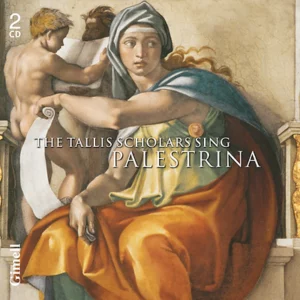Program: #94-37 Air Date: Sep 12, 1994
Note: Ted Libbey, author of the NPR Guide to Building a Classical CD Collection, joins us to share some of the works in early music that are his favorites that could not be included in the original book.
This program is Free for all, thanks to this generous Preservation Grant:
I. John Dowland: Songs for Tenor & Lute (Nigel Rogers, t./Paul O’Dette, lute). Virgin Classics CD VC 7 90726-1.
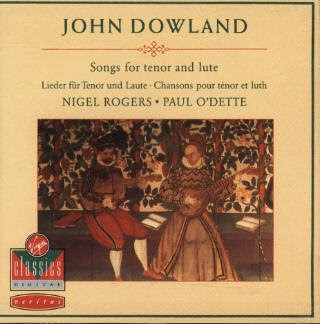
Nigel Rogers began singing at an early age as a boy treble and later became a choral scholar at King’s College, Cambridge. After graduating he went first to Italy and then to Germany, where he studied at Munich’s Hochschule für Musik. During the early 1960s he toured all over the world before returning to England, where he began to take a greater interest in Baroque music. He is accompanied here by first-class musicians: lutenists Anthony Bailes and Paul O’Dette, gambist Jordi Savall.
John Dowland is one of England’s greatest composers. In his lifetime, he was acknowledged as an outstanding lutenist, and his songs have always been popular. Dowland’s distinctive hallmark as a songwriter is his uncanny skill at creating a suitable musical atmosphere for a poem. In 1610, John’s son Robert Dowland (1591-1641), a minor composer of the time, assembled a collection of works by third-party composers entitled A Musicall Banquet and put his own name to it. His father is the most famous of the composers included; there is a suggestion that he helped his 19 year-old son with assembling the collection, hoping that the attribution would launch the young man's musical career. The musical net of the collection is cast wide, with French and Italian composers as well as English. It was the first collection of lute songs to take this approach, presenting a cross-section of European solo songs c.1600
| Book I | ||
| A1 | Come Away, Come Sweet Love | 2:01 |
| A2 | Come Heavy Sleep | 4:15 |
| A3 | Wilt Thou Unkind Thus Reave Me? | 3:40 |
| A4 | If My Complaints Could Passions Move | 3:14 |
| A5 | My Thoughts Are Winged With Hopes | 2:56 |
| A6 | Awake Sweet Love | 2:36 |
| Book II | ||
| A7 | Sorrow, Stay | 3:18 |
| A8 | Fine Knacks For Ladies | 2:33 |
| A9 | Flow My Tears | 4:14 |
| A10 | Shall I Sue | 2:32 |
| A11 | I Saw My Lady Weep | 4:00 |
| Book III | ||
| B1 | When Phoebus First Did Daphne Love | 1:45 |
| B2 | Say, Love, If Ever Thou Didst Find | 1:46 |
| B3 | Fie On This Feigning | 1:48 |
| B4 | Weep You No More Sad Fountains | 4:34 |
| Book IV (A Pilgrimes Solace) | ||
| B5 | Love Those Beams | 2:43 |
| B6 | Sweet Stay Awhile | 3:01 |
| B7 | To Ask For All Thy Love | 3:24 |
| B8 | Were Every Thought An Eye | 1:32 |
| B9 | Shall I Strive With Words To Move? | 3:17 |
II. Josquin: Missa Pange lingua (Tallis Scholars/Peter Phillips). Gimell CD GIM 009.
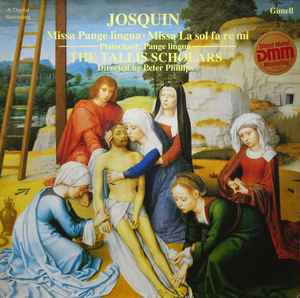
From Music Web International: Peter Phillips founded The Tallis Scholars in 1973; they are celebrating their fortieth anniversary this year. That seems to be a suitable cue to bring up to date MusicWeb International’s coverage of the issues to date in the ensemble’s series of recordings of Masses by the Flemish master, Josquin Des Prés.
The three discs under consideration here include the disc that may be said to be one of the most important that The Tallis Scholars have issued to date. With CDGIM009 they won Gramophone magazine’s Record of the Year award in 1987. This was the first time that an early music disc had received that accolade and, amazingly, it remained the only such winner of that award until 2010, I believe. In terms of recognition for The Tallis Scholars this award was a quantum leap. As Peter Phillips said when I interviewed him and Steve Smith for Seen and Heard in 2010, “It turned us into a serious proposition”. One key thing, as he explained, was that the Gramophone award was not only from specialist critics but from a panel of critics that included writers who specialised in a wide variety of music; in other words, the quality of the music and the performances generated widespread, as opposed to specialist, appeal.
Listening to the disc it’s not hard to see why it was singled out. I came across a contemporary comment by John Steane, doyen of vocal music critics, which was reprinted in his book. The Gramophone and the Voice (1999). Steane wrote in 1987 that The Tallis Scholars “are a wonderfully homogenous and disciplined group, yet sound like a choir of human beings.” Of this particular disc Steane went on to say that “[they] bring such a perceptive ear for the rhythms that they awaken a new appreciation of the vitality and joy that exist in such things.” How true! The Missa La sol fa re mi is the earlier of the two Masses; it was published in 1502. Josquin based the entire Mass on the five notes A, G, F, D, E and Peter Phillips reckons that this cantus firmus appears over 200 times during the work. Yet, to my ears, while this is an amazing technical feat the music never sounds constrained by this self-imposed framework, still less dry or academic. The music doesn’t strike me as being as extrovert as that in the companion Mass on this disc but that’s an observation, not a criticism. In the Sanctus, Josquin almost goes up through the gears: the ‘Sanctus’ itself is slow-moving and gently majestic; the ‘Pleni sunt caeli’ music is lively but the ‘Hosanna’ is even livelier and exultant. I was struck in Agnus Dei I by how many times Josquin repeats just the one word ‘mundi’, as if emphasising again and again that Christ, the Lamb of God, has taken away the sins of everyone. The same repetition occurs in Agnus Dei III where the singing is exquisitely hushed and intense.
The compositional framework for Missa Pange Lingua is a paraphrase of the plainchant hymn for Corpus Christi. Helpfully, the complete hymn is sung first. Once again, I don’t feel that the framework acts as any kind of constraint on Josquin; the music just flows with a natural inevitability. This is held to be a much later Mass than its companion; it wasn’t published until 1539, long after Josquin’s death. Peter Phillips says in his notes that this Mass has been described by one scholar as ‘a fantasy on a plainsong’. What amazes me is the sheer variety, indeed flamboyance, of Josquin’s writing for just four parts. In fact, his invention is undiminished even when he reduces his options by writing in just two parts, as at the start of the Credo where first the tenors and basses are heard, followed by sopranos and altos. In the Credo the simple, reverent homophony at ‘Et incarnatus est’ is a masterstroke after we’ve heard so much polyphony. By “restricting” himself in this way Josquin focuses attention on the mystery of the Incarnation. After this compositional self-denial he compensates, as it were, with jubilant polyphony for ‘Et resurrexit’.
The performances of these two Masses are absolutely superb. The dedication, discipline and skill required to produce such immaculate singing is quite remarkable. Beautifully recorded by Mike Clements, it’s no surprise that this disc was acclaimed so widely.
- Pange Lingua
- Missa Pange Lingua: Kyrie
- Missa Pange Lingua: Gloria
- Missa Pange Lingua: Credo
- Missa Pange Lingua: Sanctus & Benedictus
- Missa Pange Lingua: Agnus Dei I, II & III
- Missa La Sol Fa Re Mi: Kyrie
- Missa La Sol Fa Re Mi: Gloria
- Missa La Sol Fa Re Mi: Credo
- Missa La Sol Fa Re Mi: Sanctus & Benedictus
- Missa La Sol Fa Re Mi: Agnus Dei I, II & III
III. Lassus: Hieremie Prophetae Lamentationes (Paris Chapelle Royale European Ensemble/Philippe Herreweghe) Harmonia Mundi CD HMC901299.
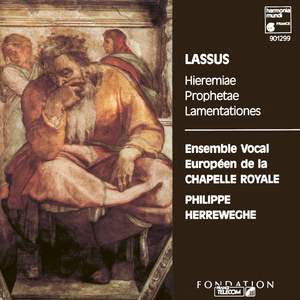
From Gramophone: Philippe Herreweghe, in the accompanying booklet to this recording invites the listener to imagine the music ''resounding beneath the vaults of an abbey, before dawn, sung by musicians involved to the very depths of their beings for whom the triduum [the three days before Easter Day] had a real and painful meaning''. Although Harmonia Mundi do not reveal where this recording was made, there is sufficient resonance to suggest a vaulted acoustic, and Herreweghe's choir (of 13 mixed voices) certainly sound involved in the music, though I very much doubt the sessions took place before sunrise. The overall effect of the recording, however, is one of the muted passion of intense contemplation, as would have befitted the solemn liturgical celebrations held during Holy Week in the composer's own day.
Lassus's settings of the Lamentations conform to the well-established traditions of the late sixteenth century, though his choice of texts is no less individual and, presumably, personal than that of his contemporaries Victoria or Palestrina. The bulk of the text is set more or less syllabically (the stress of the words thus influencing the rhythmic shape of the melodic phrases), with the Hebrew letters (Aleph, Beth, etc.) at the heart of the origins of the Lamentations of Jeremiah set as extended melismas, usually based on falling or rising scalic figures, each building to a climax but each, with this simple unity of thematic material, contributing to a cumulative structural effect. The Chapelle Royale distinguish well between the two styles, bringing a slower, more sustained intensity to the waxing and waning of the melismatic passages and a good sense of unhurried flow to the texted sections. These are urgent, without ever being pressed too hard. The balance of the choir is excellent, resulting in a vibrancy of sound in these essentially chordal textures that enhances the harmonic progressions and shapes the dissonances that make this music so affecting. Apart from the odd very slightly tentative entry, their ensemble and assurance with the idiom is equal to that of the best British mixed choirs—more proof that on the continent standards of choral singing are steadily but surely improving. Yes, the music, as Herreweghe suggests, is austere, but it has its own almost mesmeric beauty when sung with as much refinement and sensitivity as here. Highly recommended.'
Lamentatio seconda, primi diei Feria V ad matutinum in nocturno I : Lectio II 7'59
Jeudi Saint
Lamentatio prima, primi diei Feria V ad matutinum in nocturno I : Lectio I 8'03
Lamentatio tertia, primi diei Feria V ad matutinum in nocturno I : Lectio III 8'37
Vendredi Saint
Lamentatio prima, secundi diei Feria VI ad matutinum in nocturno I : Lectio I 9'17
Lamentatio seconda, secundi diei Feria VI ad matutinum in nocturno I : Lectio II 7'54
Lamentatio tertia, secundi diei Feria VI ad matutinum in nocturno I : Lectio III 8'36
Samedi Saint
Lamentatio prima, tertii diei Sabbato sancto ad matutinum in nocturno I : Lectio I 8'58
Lamentatio seconda, tertii diei Sabbato sancto ad matutinum in nocturno I : Lectio II 7'41
Lamentatio tertia, tertii diei Sabbato sancto ad matutinum in nocturno I : Lectio III 6'27
IV. The Tallis Scholars Sing Palestrina (Tallis Scholars/Peter Phillips). Gimell CD GIM 204
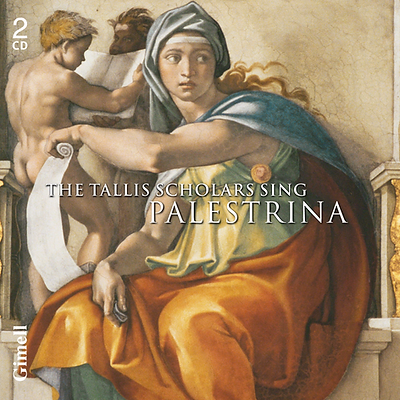
Palestrina is the composer The Tallis Scholars have sung and recorded most frequently. There need be no surprise in this: the quality of his music merits all the fame it has been accorded over the centuries, making him probably the most talked-about writer in the history of Western classical music (Beethoven, Mozart and Wagner are possible rivals in this, but with them the process hasn’t been going on for so long).
But there is more to Palestrina than his ability to write a masterpiece every time he sat down to compose: his style makes demands of its performers which no other composer quite made. We have come to realize that if a group can sing Palestrina well it can sing any choral music well, for in his music there is no hiding-place. The sonorities are so clear, the logic of the writing so compelling, that one sound out of place is immediately detectable; and a blemish is more serious in music which depends on sheer sound for its impact than in more pictorial or rhetorical compositional styles. With Lassus and Byrd, for example, interpretation through the words alone will go a long way to producing a convincing performance; Palestrina requires his performers to think more carefully about the sound itself. The nearest comparison is with the passage-work in Mozart’s piano music, which is equally so clearly and logically conceived that a stray note can acquire a disproportionate influence. Just as a pianist must rehearse scales and arpeggios to play Mozart well, so a vocal ensemble must work on blend and tuning to sing Palestrina well. There is no better or more rewarding way of learning how to sing Renaissance polyphony.
These two discs contain some of the best of our view of Palestrina, from the very first record we made commercially (in 1980), to one of the most recent (entitled ‘Lamenta’ and released in 1998). In general we have concentrated on his Mass settings – there are three more in our catalogue as well as another version of Papae Marcelli – not least because they make such effective concert music. Palestrina had an unusual ability to write positive, outward-going, major-key music which, over the length of a Mass-setting, is a great strength: penitential writing tends to be more effective in shorter bursts. Three of the four settings in this collection rely on bright sonorities; the fourth – Sicut lilium – is more subdued and sensuous, as the words of the motet require. The Lamentations, on the other hand, show a completely different side of Palestrina’s art. By dividing the text into short movements (and leaving out the Hebrew letters which are traditionally set as part of the whole) he was able to deliver a series of plangent statements worlds away from the mood of Papae Marcelli and Assumpta est Maria.
The Missa Assumpta est Maria, based on his own motet of that name which in turn is based on a short phrase of chant, is a classic example of sonorous Palestrina, its excitement achieved in large part by doubling the sopranos and tenors. The brighter sound this high-scored six-voice (SSATTB) choir produces is then emphasized in the style of the writing, which is more chordal than usual. The parody motet Assumpta est Maria shows the way in its opening bars: the three upper voices are grouped against the three lower ones in easily audible antiphony. This late-Renaissance method is then transferred to the Mass, most obviously in the Gloria and Credo but also in the first Kyrie, where greater elaboration was more customary. The sheer verve of this music has ensured that, along with Papae Marcelli, Assumpta est Maria has remained the most performed of all Palestrina’s 107 Mass-settings.
Sicut lilium by contrast is an early work, based on a motet which was published in the composer’s First Book of Motets in 1569. By contrast with the trumpet-like writing of Assumpta est Maria, the musical style here is more for string quartet, or viol consort: lucid, the working of the counterpoint at times very elaborate indeed. This can be heard at the beginning of the motet, where the point is treated to two complete expositions, from where it is transferred to the first Kyrie. Eventually all the movements except the Gloria open with imitative counterpoint. But underlying all this finely crafted polyphony is the perfumed atmosphere which the words of the motet (from the Song of Songs) originally inspired in Palestrina, and which, despite the long sentences of the Gloria and Creed, he managed to transfer to every corner of the Mass itself.
The second disc opens with a six-voice (SSATTB) set of Lamentations, originally the third lesson on the Saturday of Holy Week. Palestrina obviously felt drawn to the Book of Lamentations: he left nearly sixty individual verse-settings from it. Standardly each of these would begin with the initial Hebrew letter preserved in the Bible, but in this set they are missing. However the customary opening words are retained, as are the deeply emotive final ones: ‘Jerusalem, Jerusalem, turn to the Lord your God’. It seems that no matter how many times Palestrina set these words he found something new to say through them.
The Missa brevis (for four voices SATB), although relatively ‘short’ and straightforward in musical style, shows Palestrina’s idiom at its most accessible. It was a success from the start, being first published in 1570 and reprinted repeatedly up to 1620, since when there have been countless modern editions. Despite this, no one has been able to say what gave the music its starting-point. The most likely candidate is chant, rather than a polyphonic model as the other Masses in this set have; but if it was chant, the melodies are not applied very consistently. In fact the title ‘Brevis’ may indicate that there was no pre-existing material – rare in Palestrina’s Masses – this title filling in for the missing name of the original. The music is anyway not that short, being conceived in a fluent idiom which seems to glide effortlessly through the longer texts, until it culminates in the second Agnus. Here Palestrina abandoned any pretence at being straightforward and wrote a canonic movement which is a model of the form. The canon (a tune sung first by one voice and then by another some beats apart) is between the two soprano parts (a new one having been added to the ensemble just for this movement), making it as audible as anyone could wish. As with the best canons it seems as though it can never end.
The Missa Papae Marcelli also culminates in a canonic second Agnus, but here both the build-up and the canon itself are very different. This is the Mass which was said to have ‘saved church music’ by proving to the cardinals at the Council of Trent that words set to music could be audible even in polyphony. Dedicated to Pope Marcellus II, who had reigned for three weeks in 1555, it was probably written in 1556 and therefore dates from the years when that argument was raging. However it is hard to believe in this story entirely. Although the style of the music is syllabic at times, especially in the Gloria and Credo, it is not the case that the words are consistently more audible than in other settings of the period, something anyway made harder by using six voices (SATTBB) rather than four. Indeed the canonic second Agnus (now for seven voices SSAATBB) is one of the most complex movements of the High Renaissance, its mathematical density unequalled elsewhere in Palestrina’s output. What one can say, however, is that the setting as a whole is an unparalleled masterpiece, of the kind one returns to again and again over the years. The Tallis Scholars gave their first performance of it in March 1977 and their 75th in June 2004. I hope there will be countless more. —Peter Phillips
Assumpta est Maria in caelum
- Missa Assumpta est Maria in caelum: I. Kyrie
- Missa Assumpta est Maria in caelum: II. Gloria
- Missa Assumpta est Maria in caelum: III. Credo
- Missa Assumpta est Maria in caelum: IV. Sanctus & Benedictus
- Missa Assumpta est Maria in caelum: V. Agnus Dei
Sicut lilium inter spinas I
- Missa Sicut lilium inter spinas: I. Kyrie
- Missa Sicut lilium inter spinas: II. Gloria
- Missa Sicut lilium inter spinas: III. Credo
- Missa Sicut lilium inter spinas: IV. Sanctus & Benedictus
- Missa Sicut lilium inter spinas: V. Agnus Dei
Lamentations For Holy Saturday (Lesson 3, 6vv)
- Missa Brevis: I. Kyrie
- Missa Brevis: II. Gloria
- Missa Brevis: III. Credo
- Missa Brevis: IV. Sanctus & Benedictus
- Missa Brevis: V. Agnus Dei
- Missa Papae Marcelli: I. Kyrie
- Missa Papae Marcelli: II. Gloria
- Missa Papae Marcelli: III. Credo
- Missa Papae Marcelli: IV. Sanctus & Benedictus
- Missa Papae Marcelli: V. Agnus Dei
V. Claudio Monteverdi: Vespro della Beata Vergine (Ann Monoyios, Marinella Pennicchi, Michael Chance, Mark Tucker, Nigel Robson, Sandro Naglia, Bryn Terfel, Alastair Miles, Christopher Wilson (chitarrone), Jakob Lindberg (chitarrone) & David Miller (chitarrone)
The Monteverdi Choir, The London Oratory Junior Choir, His Majesties Sagbutts & Cornetts The English Baroque Soloists, John Eliot Gardiner). Archiv CD 429 565-2.
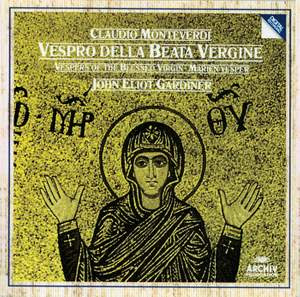
In March 1964, as a student at King’s College, Cambridge, John Eliot Gardiner led a performance of Monteverdi’s Vespers that not only launched his career as a conductor, but also provided the impetus to create his world-renowned Monteverdi Choir. In 1989, to mark the Monteverdi Choir’s 25th anniversary, he made the legendary live recording in St. Mark’s, Venice (where Monteverdi had held the position of maestro di cappella), which is re-presented in this deluxe hardback edition. This performance was also filmed by the BBC, and is included alongside the CDs.
Special deluxe edition celebrating Monteverdi’s 450th anniversary.
The term “Vespers” (evening prayers) is taken from the Hours of the Divine Office, a set of daily prayers of the Catholic Church which have remained structurally unchanged for 1500 years. In scale, Monteverdi’s Vespers was the most ambitious work of religious music before Johann Sebastian Bach. This piece includes soloists, chorus, and orchestra and has both liturgical and extra-liturgical elements.
Monteverdi’s Marian Vespers of 1610 was his first sacred work after his first publication twenty-eight years prior, and stands out for its assimilation of both old and new styles, although it cannot be specifically classified as prima pratica or seconda pratica, per se. The Vespers were published in July 1610, in combination with a six-voice mass which parodied a motet of Nicolas Gombert; In illo tempore loquante Jesu. Today, over four hundred years later, the precise intentions of this large work are not clearly known or understood. This has been a great topic of debate among musicologists for decades, and it has even been suggested by Graham Dixon that Monteverdi’s setting of the Vespers is more suited towards use for the feast of Saint Barbara, claiming, for example, that the texts taken from Song of Songs are applicable to any female saint. He goes on to write that formatting the Vespers to fit a Marian feast made the work more “marketable”. There are several facts that support this view: there are just two Marian songs in the whole work (Audi Coelum and Ave Maris Stella); the sonata could very easily be rearranged to any saint’s name; and the text of the Duo Seraphim is connected with Saint Barbara (because she is generally connected with Trinity).
The Vespers was first printed in Venice in 1610 when the composer was working at the ducal court in Mantua. Historical record does not indicate whether Monteverdi actually performed the Vespers in either city; the work may have been written as an audition piece for posts at Venice (Monteverdi became maestro di cappella at St Mark’s Basilica in Venice in 1613) and Rome (where the composer was not offered a post).
The Vespers is monumental in scale, and requires a choir large enough and skillful enough to cover up to 10 vocal parts in some movements and split into separate choirs in others while accompanying seven different soloists during the course of the piece. Interestingly, solo parts are included for violin and cornett, but the ripieno instrumentation is not specified by Monteverdi. Additionally, he did not specify a set of plainchant antiphons to insert before each psalm and the concluding Magnificat. This allows the performers to tailor the music according to the available instrumental forces and the occasion of the performance (the particular feast day’s liturgy would have included suggested antiphons that could be chanted before Monteverdi’s psalm settings). Another example of tailoring to the forces available is the fact that the collection includes two versions of the Magnificat, one of which is scored for a smaller group of musicians than the other. Some scholars have argued that this suggests that the Vespers was not intended as a single work, but it is generally performed as such.
The historical interest of this work is almost as great as its inherent qualities. Vespers are part of the daily Offices, or Canonical Hours, of the church, music for the Offices including psalms (with antiphons), hymns, and canticles, as well as chanted lessons (with responsories). Although inspired by the Church Office, Monteverdi’s Vespers in many ways transcends the original concept, perfectly exemplifying the transition between austere Renaissance polyphony and sheer Baroque splendor. Monteverdi makes his characteristic contribution to sacred music in a bold, almost operatic, style, complete with daring stereophonic and echo effects, and includes a suite of instrumental dances, concerti sections for both voices and orchestra, and a love song. To what extent this is liturgical music is debatable in view of the choice of texts, which some in Monteverdi’s time considered blasphemous. Completed in 1610, the Vespers was written for the court of the Gonzaga family in Mantua, where Monteverdi was employed from 1590 to 1612, and dedicated to Pope Paul V. But the composition’s true home is undoubtedly the cathedral of St. Mark in Venice, where Monteverdi was appointed maestro di cappella in 1613. Indeed, the Vespers could well have been conceived with its echoing spaces, galleries, balconies, organ, and choir lofts in mind.
The sections contain striking contrasts, but the unity and continuity of Monteverdi’s grand design is maintained theatrically as well as musically. The overture, for choir and orchestra, is manifestly operatic, and close to that of Monteverdi’s first opera, Orfeo – an upsurge of joyous energy, interposed by an orchestral toccata and ending with a jubilant Alleluia. The instrumentation (cornets, sackbuts, a variety of single and double reeds, recorders, strings, organ, and harpsichord) is, with the exception of the instrumental ritornelli, mainly intended to contribute to the formal structure of the choral sections, coloring the choir in the manner of organ stops, as in the “Dixit Dominus,” “Laetatus sum,” “Audi, coelum,” and the beginning and end of the closing Magnificat, the climax of the whole work. The ways in which Monteverdi treats the cantus firmus by incorporating it into the counterpoint of the choral writing, as in “Dixit Dominus” (Psalm 109), is not found in earlier choral literature, nor is the flowing, unfettered parlando (recitation) style used in “Nigra sum,” a metrically free poem with allusions to the biblical Song of Solomon. The concerto “Due Seraphim” is probably the most interesting section in the Vespers. It is set for two “answering” voices – a sort of singing competition for angels – and almost exceeds the limits of human vocal technique. The choral writing is also demanding in its splendor and complexity, much of it in six, seven, and, as in the psalm “Laudate pueri,” eight parts; yet the simplicity of the two-part hymn Ave Maris stella is also among the many treasures of this magnificent work.
Back in 2010, Gardiner had already conducted the Vespro at Versailles’ Chapelle Royale, winning broad acclaim; this is the reason why it was decided to film the 2014 concert. The title page of the first edition is inscribed “ad Sacella sive Principum Cubicula accomodata Opera” (for use in princely rooms and chapels). According to the conductor, Versailles Chapelle Royale is the perfect place to perform this masterpiece, because the spatial disposition makes the audience experience the feeling of Renaissance concerts: the architecture and the various levels enhance the echo and the dialogs between the singers, performing from different heights.
- 2:10 Domine ad adiuvandum (This opening movement makes use of musical elements from the introduction to Monteverdi’s Orfeo – 1607)
- 4:38 Dixit Dominus (Psalm 110) Six-voice choir and six instruments
- 13:13 Nigra sum sed formosa (Motet) solo tenor
- 17:58 Laudate, pueri, Dominum (Psalm 113) Eight-voice choir and organ
- 24:15 Pulchra es, amica mea (Motet) (from Song of Songs) Vocal duet
- 28:32 Laetatus sum (Psalm 122): Six-voice choir
- 36:24 Duo Seraphim clamabant (Motet) (Isaiah 6:2-3; 1 John 5:7) Vocal duet leading into trio
- 43:53 Nisi Dominus aedificaverit domum (Psalm 127) Ten-voice choir
- 48:54 Audi, coelum, verba mea (Motet) (anonymous liturgical poem): Two tenor soloists singing call and response (prima ad una voce sola)
- 58:08 Lauda, Jerusalem, Dominum (Psalm 147): Two choirs of three voices plus tenor cantus firmus
- 1:03:33 Sonata sopra ‘Sancta Maria’ ora pro nobis (Sopranos and instruments)
- 1:11:01 Ave maris stella (8th-century plainsong hymn) Two choirs and soloists
- 1:21:20 Magnificat
Composer Info
John Dowland, Josquin Des Prés, Orlando de Lassus, Giovanni Palestrina, Claudio Monteverdi,
CD Info
Virgin Classics CD VC 7 90726-1, Gimell CD GIM 009, Harmonia Mundi CD HMC901299, Gimell CD GIM 204, Archiv CD 429 565-2.
